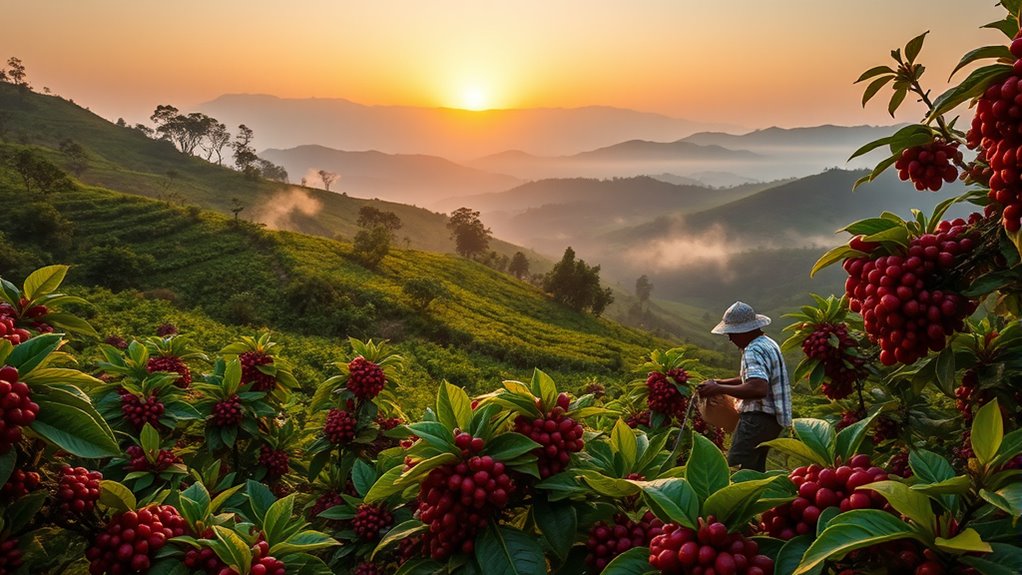Ethiopian coffee from Sidama, Yirgacheffe, and Guji offers unique flavors rooted in centuries-old traditions and ideal growing conditions. You’ll notice vibrant, fruity notes from Sidama, floral and citrus hints from Yirgacheffe, and rich, earthy tones from Guji. These regions use sustainable, shade-grown farming practices that enhance quality. Exploring their brewing styles reveals complex aromas and layered flavors. Stick around to discover how each region’s history and land shape your perfect cup.
Key Takeaways
- Sidama, Yirgacheffe, and Guji are renowned Ethiopian coffee regions, each offering distinct flavor profiles influenced by unique climates and altitudes.
- These regions primarily cultivate high-quality, shade-grown beans using traditional farming practices focused on sustainability.
- Sidama coffee is known for its bright acidity and fruity notes, while Yirgacheffe offers floral and citrus flavors, and Guji features rich, wine-like qualities.
- Traditional brewing methods like the Ethiopian jebena enhance the coffee’s earthy and layered aroma profiles.
- Understanding each region’s unique growing conditions and cultural practices deepens appreciation of Ethiopia’s rich coffee heritage.

Have you ever wondered what makes Ethiopian coffee world-famous? It’s a combination of rich history, unique growing conditions, and an unwavering dedication to quality. When you explore Ethiopian coffee, you’ll find that its distinctive flavors are rooted in the way coffee farming is practiced across regions like Sidama, Yirgacheffe, and Guji. Coffee farming here isn’t just about planting beans; it’s a tradition passed down through generations. Farmers meticulously tend to their coffee trees, often using age-old methods that emphasize sustainability and respect for the land. Many farms are smallholder plots, where coffee is cultivated under the shade of indigenous trees, enhancing the beans’ flavor complexity. The altitude, soil, and climate in these regions create the perfect environment for growing high-quality coffee beans. As a result, the beans develop unique characteristics that are celebrated worldwide. Additionally, Ethiopia’s emphasis on sustainable farming practices plays a vital role in maintaining the land’s health and ensuring the long-term quality of the coffee.
Once the beans are harvested, the journey to brewing begins. Brewing techniques play a crucial role in highlighting the nuanced flavors of Ethiopian coffee. Whether you’re using a pour-over, French press, or espresso machine, the method you choose influences the final taste. For instance, pour-over brewing allows you to appreciate the coffee’s bright acidity and floral notes, often found in Yirgacheffe beans. On the other hand, a French press can bring out a richer, fuller body, which pairs beautifully with the fruity and spicy flavors typical of Sidama coffee. Many locals and connoisseurs also experiment with traditional methods like the Ethiopian jebena, a clay coffee pot that imparts a distinctive earthy aroma to the brew. Mastering brewing techniques is essential to reveal the full potential of Ethiopian beans, which are known for their complex aroma and layered flavors.
In Ethiopia, coffee isn’t just a beverage; it’s a cultural experience. The way coffee is grown and brewed reflects a deep respect for tradition and a desire to preserve authenticity. As you explore these regions, you’ll notice how every step, from coffee farming to brewing techniques, contributes to the extraordinary quality of Ethiopian coffee. When you sip a cup, you’re tasting centuries of craftsmanship and a land that has dedicated itself to producing some of the finest coffee in the world. So, whether you’re savoring a cup at home or visiting Ethiopia, understanding the importance of coffee farming and brewing techniques will deepen your appreciation for this vibrant, historic beverage.
Frequently Asked Questions
Which Ethiopian Coffee Region Produces the Most Globally Awarded Beans?
You’ll find that Sidama produces the most award-winning beans among Ethiopian regions, gaining significant global recognition. Its innovative cultivation methods and unique flavor profiles have earned numerous awards, making it a standout in the international coffee scene. If you’re seeking award-winning Ethiopian coffee, Sidama’s beans are your best bet for quality and distinction, reflecting its reputation as a top producer with a strong presence in global competitions.
How Do Altitude and Climate Specifically Affect Flavor Profiles?
Altitude and climate dramatically shape coffee flavors, making your cup an extraordinary experience. When you’re at high mountain elevations, the cooler temperatures slow bean maturation, intensifying complex, vibrant flavors. Climate variability, like seasonal shifts, influences acidity and body, adding layers to each sip. You’ll notice that beans grown at different elevations and in diverse climates deliver a spectrum of tastes, from bright and citrusy to rich and chocolatey—truly a flavor adventure!
What Is the Best Way to Brew Ethiopian Coffee at Home?
To brew Ethiopian coffee at home, start with a pour-over or French press for ideal flavor extraction. Use freshly ground beans and precise brewing techniques, like controlling water temperature around 200°F. Adjust grind size to match your brewing method, ensuring you highlight the coffee’s bright, fruity notes. Keep your brewing time consistent, and enjoy the vibrant flavors that showcase Ethiopia’s unique coffee profile.
Are There Any Ethical Certifications for Ethiopian Coffee Farms?
Imagine walking through lush Ethiopian coffee farms, where vibrant green leaves whisper stories of care. Yes, many Ethiopian coffee farms hold ethical certifications like Fair Trade and Organic. These labels guarantee farmers receive fair wages and use environmentally friendly practices. By choosing certified coffees, you support sustainable farming, protect local communities, and enjoy your brew knowing it was grown with respect for people and the planet.
How Does Processing Method Influence the Taste of Sidama, Yirgacheffe, and Guji Coffees?
Processing techniques profoundly influence flavor development in Sidama, Yirgacheffe, and Guji coffees. Washed processing results in bright, clean cups with pronounced floral and citrus notes, perfect for highlighting the beans’ natural qualities. Natural processing, on the other hand, creates a fruitier, fuller-bodied profile with added sweetness. You’ll notice these differences in aroma and taste, allowing you to select coffees that match your preferred flavor profile based on how they’re processed.
Conclusion
Now that you’ve explored Ethiopia’s renowned coffee regions like Sidama, Yirgacheffe, and Guji, you’re ready to appreciate each cup’s unique story. Imagine visiting a local farm in Yirgacheffe, witnessing the careful handpicking of beans, and tasting the vibrant, floral flavors firsthand. By understanding these origins, you’ll enjoy a richer coffee experience and support sustainable practices. So next time you brew your cup, remember the journey behind those unforgettable Ethiopian flavors.









